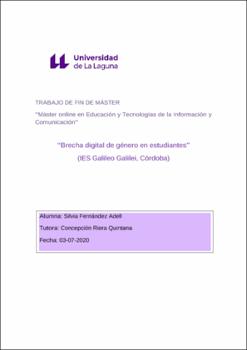Brecha digital de género
Author
Fernández Adell, SilviaDate
2021Abstract
Las nuevas tecnologías de la información y comunicación (TIC) se han integrado en diversas áreas de nuestra vida, ello conlleva una serie de beneficios y/o oportunidades, pero a la vez, puede conllevar barreras y/o dificultades para algunos sectores de la población. Las mujeres, debido al predominio de una sociedad patriarcal, han visto como sus oportunidades de avanzar han estado limitadas por diversos factores. Las TIC se han convertido en uno de ellos, generando la brecha digital de género. El presente trabajo recoge los resultados de un estudio realizado a alumnado de Formación Profesional de un centro público de Andalucía, cuyo objetivo ha sido, por un lado, identificar las posibles diferencias, según género, en el uso y acceso a TIC e Internet, y por otro lado, conocer la percepción de las capacidades del alumnado respecto a sus competencias digitales. Para la recogida de la información se ha realizado un cuestionario con 18 preguntas. Los resultados señalan que, en la muestra analizada, no existen grandes diferencias en cuanto a la utilización de las TIC e Internet. Abstract. The new information and communication technologies (ICT) have been integrated into various
areas of our lives, this entails a series of benefits and/or opportunities, but at the same time, it can lead to barriers and/or difficulties for some sectors of the population. Women, due to the predominance of a patriarchal society, have seen how their opportunities to advance have been limited by various factors. ICTs have become one of them, generating the digital gender gap. The present work collects the results of
a study carried out on Certificate of Higher Education students from a public center in Andalusia, whose objective has been, on the one hand, to identify possible differences, according to gender, in the use and access to ICT and the Internet, and on the other hand, to know the perception of the students' abilities regarding their digital competences. To collect the information, a questionnaire with 18 questions has been prepared. The results indicate that, in the sample analyzed, there are no great differences in terms of the use of ICT and the Internet.





